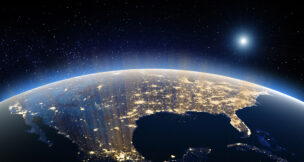Trump’s steel, aluminum tariffs could impact Va. economy
Much depends on how long proposed tariffs last, experts say
Beth JoJack //February 10, 2025//

AdobeStock photo

AdobeStock photo
Trump’s steel, aluminum tariffs could impact Va. economy
Much depends on how long proposed tariffs last, experts say
Beth JoJack //February 10, 2025//
President Donald Trump imposed 25% tariffs on steel and aluminum imports Monday. Now, the world waits to see what impact they will have.
“If you look at the behavior of investors, investors are signaling again that they don’t believe these tariffs will be long-lived,” said Bob McNab, chair of Old Dominion University’s Department of Economics and director of the Dragas Center for Economic Analysis and Policy. “If you’re looking at statements from the administration and president, they are suggesting that the tariffs may be in place for a while.”
After all, McNab noted, U.S. stocks rose Monday.
So far, Trump’s threatened tariffs on Mexico and Canada have led to deals to delay enforcement, preventing retaliatory tariffs by those countries, so investors are not sure whether the steel and aluminum tariffs are for real or a bargaining chip. Trump told reporters about the tariff announcement as he flew to Louisiana for the Super Bowl on Sunday.
But depending on how long the tariffs are enforced, McNab said, Virginia consumers and business owners could take a hit to their pocketbooks.
“If we see the tariffs come into play and remain in force for an extended period of time, then prices of imported steel and aluminum obviously are going to rise, but the price of domestically produced steel and aluminum will rise as well, and those costs will be passed along to American businesses and consumers,” he said.
McNab described a person standing in an empty pool and holding a hose to fill it with water.
“It might start off barely nipping at your toes, and at some point it’s at your knees, and at some point it’s at your nose, and then it’s above your head,” he said. “Sort of like that, the effects will accumulate over time and grow larger over time as the costs of goods increase, and then we start to see firms and consumers make decisions about consumption due to the higher price of goods.”
The tariffs will have a bigger impact on states where steel and aluminum production is concentrated than it will on the commonwealth, McNab believes.
“I haven’t seen anything that suggests that we’re wildly different from any other state,” he said of Virginia.
In 2018, Trump imposed tariffs of 25% on steel and 10% on aluminum, although some countries — including Australia, Canada and Mexico — got breaks on the duties.
The Biden administration later rolled back some trade restrictions on steel and aluminum tariffs with the European Union, the United Kingdom and Japan.
Fred Treyz, CEO and chief economist of REMI, a Massachusetts based policy modeling firm, said northern states with economies that rely heavily on automotive manufacturing stand to take larger hits, because those companies work hand in hand with Canada.
“That’s disruptive to the auto industry, even to the U.S. side of the auto industry because they’re working together,” he said.
For Virginia’s aluminum manufacturers, he said, tariffs could actually help business by providing protection from competition outside the United States, Treyz said. “So it does tend to give the domestic manufacturer more pricing power, so they can increase their prices and increase their output if they’re not facing the international competition.”
Neither Crown Holdings, which has a beverage can manufacturing facility facility in Henry County, nor Belvac, which produces technology for the two-piece can industry at a Lynchburg facility, immediately returned a request for comment.
Chris Gregory, executive vice president at SteelFab, a steel fabricator with a fabrication plant in Emporia, sent an email Monday night, explaining that the company was waiting to learn more details about the tariffs. “But we are bracing ourselves for pricing increases across the board,” he wrote.
Ben Phelps, vice president of Frederick County’s Winchester Metals, explained in an email that tariffs would impact the steel distribution, processing and fabrication facility, but added that it won’t necessarily be in a negative way.
“We generally pass on any raw material increases that we incur to our customers,” he wrote. “Our business is more transactional as opposed to contractual, so we’re not locked into price points.”
Impact on data centers
It’s well established that Virginia is popular with data center developers because of its location near Washington, D.C., and internet exchange points, as well as its business friendly environment.
Data center developers are also fans of steel, which they often use for the exteriors of buildings and for use in things like enclosure racks and HVAC systems.
David Smith, a senior vice president with Cushman & Wakefield | Thalhimer, doesn’t think the tariffs on steel imports will cause data center developers to hit pause on their plans, however.
“I wouldn’t expect the tariffs to have a long-term negative impact on data center development at all,” said Smith, who specializes in land sales in the Richmond area and often works with data center developers.
The cost of real estate and the cost to put up data center buildings “relative to what the data centers generate in income is very small,” he said.
The increased cost of materials due to tariffs won’t be enough to erase that profitability, according to Smith. For developers who are just beginning their journey to get data centers built, he said, tariffs are likely be a nonfactor. It takes developers an average of four to seven years to get the necessary approvals from localities and utilities after purchasing land to build data centers, according to Smith.
“It would be my expectation that the tariff situation on steel and aluminum by that time will be long ironed out and resolved,” he said.
Last week, Trump threatened to impose 25% tariffs on goods from Canada and Mexico as retaliation for illegal immigration and fentanyl trafficking. However, he later agreed to pause those discussions for 30 days after leaders in both countries issued plans to increase border security. Trump implemented a 10% tariff on China last week and Chinese tariffs of 10% to 15% on some U.S. products were set to take effect Monday.

















